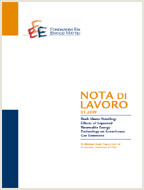Climate Policy and the Optimal Balance between Mitigation, Adaptation and Unavoided Damage

04.03.2010
Francesco Bosello, Carlo Carraro, Enrica De Cian
Q54, Q56, Q43
Climate Change Impacts, Mitigation, Adaptation, Integrated Assessment Model
Climate Change and Sustainable Development
Carlo Carraro
It has become commonly accepted that a successful climate strategy should compound mitigation and adaptation. The accurate combination between adaptation and mitigation that can best address climate change is still an open question. This paper proposes a framework that integrates mitigation, adaptation, and climate change residual damages into an optimisation model. This set-up is used to provide some insights on the welfare maximising resource allocation between mitigation and adaptation, on their optimal timing, and on their marginal contribution to reducing vulnerability to climate change. The optimal mix between three different adaptation modes (reactive adaptation, anticipatory adaptation, and investment in innovation for adaptation purposes) within the adaptation bundle is also identified. Results suggest that the joint implementation of mitigation and adaptation is welfare improving. Mitigation should start immediately, whereas adaptation somehow later. It is also shown that in a world where the probability of climate-related catastrophic events is small and where decision makers have a high discount rate, adaptation is unambiguously the preferred option. Adaptation needs, both in developed and developing countries, will be massive, especially during the second half of the century. Most of the adaptation burden will be on developing countries. International cooperation is thus required to equally distribute the cost of adaptation.
***
Suggested citation: Francesco Bosello, Carlo Carraro, and Enrica De Cian, Climate policy and the optimal balance between mitigation, adaptation and unavoided damage, Clim. Change Econ. 01, 71 (2010), http://www.worldscientific.com/doi/abs/10.1142/S201000781000008X
